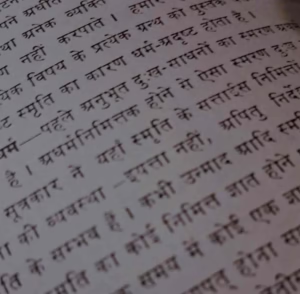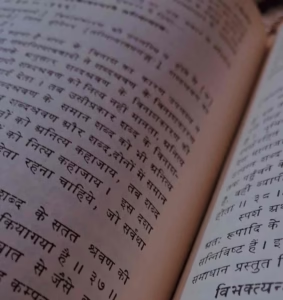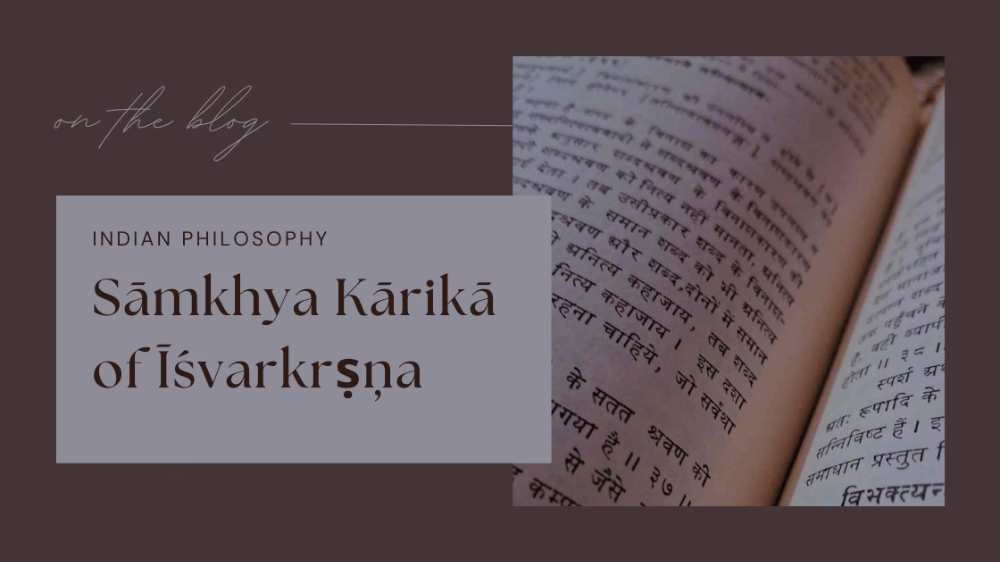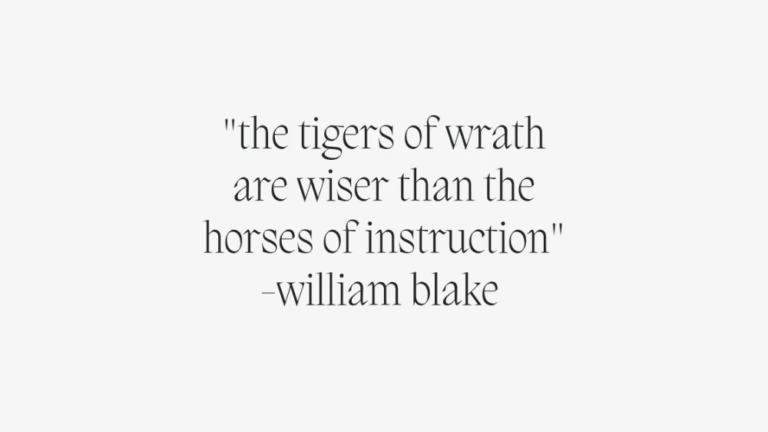Sāmkhya Kārika of Īśvarkṛṣṇa—The Mind Matter Dualism of Indian Philosophy
Have you ever read about the mind-body dualism theories. In Indian philosophy, the most prominent and one of the oldest schools of thought which talks about this dualism as one of its major metaphysical points is Sāmkhya. The famous Sāmkhya duality of mind/spirit or Puruṣa and matter or Prakṛti is briefly explained here as it occurs in the Sāmkhya Kārikā of Īśvarkṛṣṇa.
Table of Contents
This text has a beautifully logical and consistent structure which makes it one of the most easily understandable and an extremely reasonable texts of Indian Philosophy. Composed of only 72 verses, this text of Īśvarkṛṣṇa manages of give an account of the whole process of creation and evolution of the world with its dualistuc conception of Puruṣa and Prakṛti.

The first sūtra of Sāṁkhya Kārika lists the three types of suffering or dukha and claims that it the desire to end them that leads us to this inquiry. The text is a detailed explanation of the means of ending the three types of suffering and thereby attaining Kaivalya or Liberation.
Purpose Of Sāmkhya Kārika
दुःखत्रयाभिघाताज्जिज्ञासा तदभिघातके हेतौ । दृष्टे साऽपार्था चेन्नैकान्तात्यन्ततोऽभावात् ॥१ ॥
duḥkhatrayābhighātājjijñāsā tadabhighātake hetau । dṛṣṭe sā’pārthā cennaikāntātyantato’bhāvāt ॥1 ॥
There are three kinds of dukha that people experience in their life. Theses are:
Internal or Intra-organic (Ādhyātmika) which is either bodily pain caused by the disorder of vāta, pitta and kapha; or mental misery caused by anger, envy, greed and so on.
External (Ādhibhautika) influences like other human beings, animals and birds also cause us pain.
Supernatural (Ādhidaivika) agencies like evil spirits, demons and the influence of planets etc cause us the third type of pain.
Removal of these three kinds of pain cannot be attained by the visible or easy means that we think are available readily like rituals or sacrifices. These methods of pain removal are impermanent and often doubtful.
For the eternal and certain removal of pain, one needs to take the superior path of gaining the discriminative knowledge of the Manifest (vyakta) and Unmanifest (avyakta). The rest of the text is an exposition of these two concepts and how their knowledge leads to enlightenment.
Prakṛti and Puruṣa
The dualism of matter and spirit—Prakṛti and Puruṣa—is famously attributed to Sāṁkhya school and its metaphysical sibling, Yoga School of philosophy. Sāṁkhya’s conception of this dualism is central to its position on the process of liberation and creation.
Prakṛti is the root cause or the primary matter which gives rise to all the elements of the world. Puruṣa is the spirit or the
There are five primary reasons listed for prakṛti in the text. Its existence may be attributed to and be explained by
- The finite nature of objects, which implies the presence of an infinite cause.
- The homogeneity that exists in the world points to a unified, singular cause.
- Evolution which must occur because of the efficiency of the cause. This efficiency is latent in the cause and is the nature of prakṛti.
- Because there is a distinction between cause and effect.
- There exists something that holds the entire world together even despite all the differences. This blending or merging together would not be possible without the root cause.
Similarly, five points are presented to explain the existence of the spirit or puruṣa.
- The puruṣa exists because there must be something distinct from the prakṛti and its evolutes. The composites of the prakṛti must be for another’s sake and this another is called puruṣa.
- There must be something that is devoid of the three guņas.
- The spirit exists as the controller, since there must be something to preside over all of the physical world.
- There also must be an enjoyer or experiencer to enjoy the manifest world.
- The existence of the spirit can be derived from the tendency of all things to work toward final liberation or kaivalya.
कैवल्यं माध्यस्थ्यं द्रष्टृत्वमकर्तृभावश्च
kaivalyaṁ mādhyasthyaṁ draṣṭṛtvamakartṛbhāvaśca
It is pure witness and observer. Puruṣa is neutral, a seer and a non agent. It is solitary and neutral because of the absence of the three guṇas. However, it does not mean that it is not active.
Prakṛti is that object of enjoyment which is enjoyed by puruṣa. The two are completely different from each other.
Vyakta and Avyakta
The Vyakta or the manifest is that which we can perceive in front is us in the form of the physical world. It is producible, non eternal, non pervasive, active, dependant on its cause and it is manifold. The unmanifest or Avyakta is the reverse of this. It is without cause, eternal, pervasive and inactive. It is immobile even though it undergoes evolution to form the manifest.

Both the manifest and the unmanifest are the aspects of prakṛti. As the primary cause, prakṛti is unmanifested and in its raw form. However when it undergoes evolution because if the synamic nature of the three guṇas, prakṛti takes the form of the manifest physical world.
Triguṇa (The Three Guṇas)
There are three Guṇas acknowledged in Indian Philosophy—Sattva, Rajas and Tamas.
सत्त्वं लघु प्रकाशकमिष्टमुपष्टम्भकं चलं च रजः । गुरु वरणकमेव तमः प्रदीपवच्चार्थतो वृत्तिः ॥ १३ ॥
sattvaṁ laghu prakāśakamiṣṭamupaṣṭambhakaṁ calaṁ ca rajaḥ । guru varaṇakameva tamaḥ pradīpavaccārthato vṛttiḥ ॥ 13 ॥
Sattva Guṇa is the attribute of light and buoyancy. It is illuminating, enlightening and the purest of the three attributes. When people say they are consuming only sattvic food, they refer to this definition of sattva—pure and light.
Rajas Guṇa is the attribute of excitation and mobility. It is the energy that nudges the other two attributes into action.
Finally, Tamas Guṇa is sluggish and obscuring. It is heavy, inert and lazy.
These three do not contradict each other because of their different qualities. Instead they all work together toward a single goal.
Both Sattva and Tamas guṇas are inactive by nature. It is the Rajas guṇa that wakes them from their sleep and excites them to accomplish their effects. Because of its mobility, Rajas guṇa keeps the three guṇas in a continuous state of activity. This dynamism of the guṇas leads to the process of evolution of prakṛti from the unmafinest cause to the manifest physical world.
Process of Creation—Evolution
From prakṛti, the first thing that evolves is Mahat—the Great Principle. When this Mahat is under the influence of sattva guṇa, it is known as buddhi, and may be defined as the adhyavasāyaḥ—meaning ascertainment or will.
After Buddhi, Ahaṁkāra is produced and it is also called ego or the I-principle. Ahaṁkāra gives rise to the set of eleven sense organs from the sattva attribute, and it gives rise to the set of five primary elements when it is under the influence of the tamas attribute.
However, this does not mean that the Rajas attribute does not have any purpose. Even though it does not produce any separate product, it energises both sattva and tamas attributes which are completely inactive by themselves.
The eleven sense organs include the five organs of cognition (buddhi indriyāṇi) , the five organs of action (karmendriyāṇi) and Mind (manas).
The five organs of cognition are:
- Eye (cakṣuḥ)
- Ear (śrotram)
- Nose (ghrāṇa)
- Tongue (rasanā)
- Skin (tvak)
Consequently, the five organs of action or motor organs are:
- Speech (vāk)
- Hand (pāṇi)
- Feet (pāda)
- Anus (pāyu)
- Generative organ (upasthaḥ)
Finally, Manas or the mind possesses the nature of both the sense and motor organs. It is a deliberating principle, which means that it appears in the form of deliberation. Whenever you look at an object that is vague and you can only think that this is something, then it is your mind which ultimately thinks about it and comes to the conclusion about what it really is.
For example—imagine that you are standing in the middle of the road and you see a large thing from very far away coming toward you. Here, your sense organs can only tell you that it is something big and square shaped and moving. From your mind, you immediately figure out that it must be a car that is coming toward you and you step away.
From the Tamas attribute of Ahaṁkāra, the five Tanmātras, and from these emerge the five gross elements (pañca bhūtāni) such as ether (ākāśa), air (vāyu), fire (Agni), earth (Prithvi) and water (jala).
The physical world as we know it is made up of these five elements. This is how the unmanifest prakṛti evolves under the influence of the three guṇas to form the manifest world.
Kaivalya (Liberation)
What is liberation? In Indian philosophy, there are different conceptions of what is called liberation or enlightenment in the western tradition. The yoga and Sāmkhya schools call it Kaivalya, as do the Jainas. Mokṣa is used primarily in Buddhism and the Bhagvad Gīta. The Nyāya and Vaiśeṣika schools also use the term Apavarga for liberation.
In Sāmkhya Kārika, Kaivalya or liberation is characterised by the state of self realization of the puruṣa where one has the discriminative knowledge of the different between the puruṣa and prakṛti and between the manifest and the unmanifest. Only when we realise that the pains of this body are not the pain of the spirit then we can attain Kaivalya.
Having shown how the evolution of prakṛti from unmanifest cause to mainifest world takes place, the Sāmkhya Kārika goes on to show the painful nature of this evolution.
तत्र जरामरणकृतं दुःखं प्राप्नोति चेतनः पुरुषः ।लिङ्गस्याविनिवृत्तेः, तस्माद् दुःखं स्वभावेन ॥ ५५ ॥
tatra jarāmaraṇakṛtaṁ duḥkhaṁ prāpnoti cetanaḥ puruṣaḥ | liṅgasyāvinivṛtteḥ, tasmād duḥkhaṁ svabhāvena ॥ 55 ॥
The sentient spirit (puruṣa) experiences pain because of decay and death on account of the non-cessation of the subtle body. Therefore, pain is in the very nature of things.
Even thought the body, as long as it is alive, is a means to enjoy the prakṛti, there is still constant pain caused by death and decay surrounding all of us. Everyone has the fear of death and longs for life. Since the spirit doesn’t yet know that it is different from the body, it thinks that the pains of the body is its own. Puruṣa fails to realise that death and decay are only the properties of the body.
The prakṛti creates for the sake of puruṣa, so that the puriṣa may realise that it is different from the prakṛti. Through this realisation comes puruṣa’s liberation. Mokṣa or Kaivalya or liberation occurs when the puruṣa is established in its own true nature as different from the material world (the manifested prakṛti).
Thus, even though it may seem like prakṛti acts for its own sake and creates the world, the truth is that the entire process of evolution takes place for the puruṣa so that it may attain Kaivalya. After this happens, the prakṛti stops operating and goes back to its state of passivity. Just like a dancer puts up a performance for the audience and having shown the different poses, stops dancing, similarly the prakṛti, having shown it’s different modifications to the puruṣa, stops operating.
The puruṣa was never bound, nor is it ever liberated. It only realises that it always was liberated. Knowledge itself is the metaphor of liberation. Puruṣa realises after gaining the discriminative knowledge of vyakta and avyakta that it had been liberated all along. It is the prakṛti that was bound up and gets released with the help of the spirit.
From this truth comes absolute knowledge (Kaivalyam) and the spirit knows that ‘I am not’ and that ‘nothing is mine’.
Eventually, when the prakṛti stops all activity and the spirit is completely separated from the body, then puruṣa obtains final and absolute liberation.
Here’s an amazon link to the hardcopy version of the text. If you want the public domain link to the pdf version, you can find it here at Internet Archive.
If you want to read about the Yoga Philosophy—the sister school of Sāmkhya Philosophy, then you can check out this post for a brief essence of the Yoga Sūtra of Patañjali.




